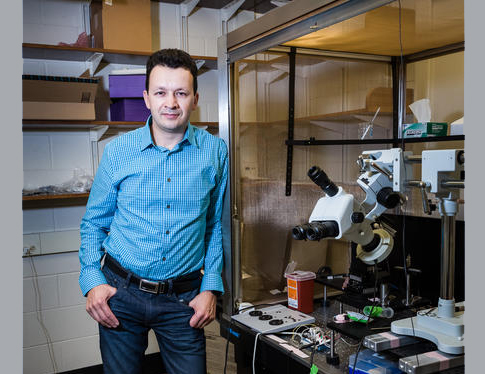Dr. Chubykin receives grant to study fragile X syndrome
11-15-2017

October 26, 2017
Purdue professor receives grant to study fragile X syndrome
WEST LAFAYETTE, Ind. — Alexander Chubykin, an assistant professor of biological sciences at Purdue University, has been awarded a $1.9 million grant from the National Institute of Mental Health to study impaired visual learning caused by fragile X syndrome.
Fragile X syndrome is the most common inherited form of autism. It’s caused by a mutation in the FMR1 gene, which provides instructions for making the protein that aids in developing the connections between nerve cells, called synapses. Affected individuals can have a range of developmental issues, including learning disabilities and cognitive impairment.
“There is a new influential predictive coding theory, which is becoming more and more popular in cognitive neuroscience, suggesting that our brains perform computations by trying to predict what will happen in the future based on our previous history of experiences,” said Chubykin.
The theory says that with each step of this computation, our brain compares the sensory input with past experiences, and the difference is a so-called prediction error. If you see something new or unexpected, there is a large prediction error, which prompts the brain to adjust – to learn and take into account the new experience. Once you take that into account, you minimize the prediction error.
Chubykin believes that impairments in circuit connectivity and changes in the strength of connections between synapses may negatively affect this process.
This could be why affected individuals are not as flexible in adjusting – they often perform repetitive movements and behaviors, and prefer strict routines.
“Our intention is to map the neurocircuits involved in predictive coding,” Chubykin said. “We’re also going to expose fragile X mice to different visual stimuli and record their responses. We want to understand how they learn and how they change their responses based on visual experiences.”
The ultimate goal is to develop better diagnostic tools, which will involve visual stimuli. Autism and fragile X syndrome are neurodevelopmental disorders, and the sooner you diagnose them, the likelier you are to minimize its effects.
Currently, there are no drugs to treat autism – only behavior therapies. But Chubykin thinks there might be hope for a pharmacological solution. By targeting the specific biochemical pathway involving the FRM1 gene, a drug could potentially mitigate the symptoms.
“If we can do it in mice, we could potentially do it in human clinical trials in the future,” he said.
Writer: Kayla Zacharias, 765-494-9318, kzachar@purdue.edu
Source: Alexander Chubykin, 765-496-0064, chubykin@purdue.edu